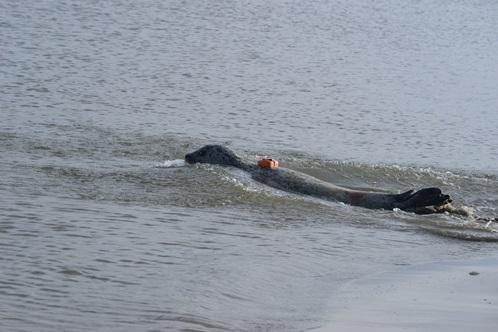Methods used to design F1 cars and spacecraft have played a crucial role in new research into the tags used to track animal movements

Credit: Dr. Abbo van Neer
Methods used to design F1 cars and spacecraft have played a crucial role in new research into the tags used to track animal movements.
Ecologists joined forces with aerospace colleagues at Swansea University to find the best way to reduce the drag of biologging tags – the recording devices used to track animal movements and behaviour.
Their research collaboration meant the bioscientists were able to take advantage of Computational Fluid Dynamics (CFD) – virtual fluid flow analysis carried out by a supercomputer – to run complex simulations of how a tag would affect a seal when moving through water.
Will Kay, from the Swansea Lab for Animal Movement (SLAM), worked with fellow PhD student David Naumann, from the University’s renowned Zienkiewicz Centre for Computational Engineering, who is part of the team working on the Bloodhound supersonic car.
The team also included undergraduate students, academic supervisors and technicians from the College of Science and College of Engineering, as well as external partners from Natural Resources Wales.
Their paper Minimizing the impact of biologging devices: Using Computational Fluid Dynamics for optimizing tag design and positioning has just been published in the prestigious Methods in Ecology and Evolution, published by the British Ecological Society and Wiley, a world-leading biosciences journal.
Will said: “For animals like seals that move in very fast flowing currents, drag is a key issue and streamlining tags is very important. Previous research has been carried out on how tag size, shape and position affect the drag on the animal, but we wanted to look how a combination of these factors work together to affect drag. We also aimed to provide a step-by-step guide for other bioscientists looking to apply these techniques themselves.”
Biologging tags are used on animals for many reasons, such as to find out more about the transmission of disease, or to understand what habitats they use to improve conservation strategies. However, carrying a tag that causes drag can change an animal’s power requirements, and might mean an animal needs to change its behaviour accordingly.
“My research began by examining tags for seals. We wanted to understand what the most important factors were for making a tag more hydrodynamic,” he said.
“Looking at the hydrodynamics (the water flow around a body) of a tag on an animal identifies what enables the tag to slip through the water easily and what features act to impede progress,” explains co-author Professor Rory Wilson, from SLAM.
By modelling the drag of tags in a computational environment Will and his colleagues were able to test the drag loading of different tags and discovered that improving tag shape was most important for reducing drag. In fact, tags could actually be made slightly larger so long as their shape was improved.
Will said: “As an ecologist this research was not something I could have done on my own and that was what inspired this collaboration. Running the simulations of the different tags in different positions takes a lot of time, so we were able to capitalise on the expertise of aeronautical engineers and use the same kind of techniques used for designing F1 cars and rockets.”
Their results also showed that a having a hydrodynamic design can reduce the impact of a tag’s position on device-induced drag. This is particularly important as it is not always possible to place a tag in the optimum position on an animal.
The researchers now hope their findings will not only act as a guide to establishing interdisciplinary collaborations with engineers but will also help other researchers to increase their understanding of tag-induced drag.
“While we don’t expect our findings to be taken up as strict, formal guidelines, nor the use of CFD to be made compulsory, we hope that this work, and especially the step-by-step guide the paper contains, will aid the biologging community towards achieving best practice in tag design,” added co-author Professor Luca Börger, of SLAM
Will aims to continue his research into seals and seabirds after his PhD after accepting a position with the British Antarctic Survey, working with Antarctic fur seals and leopard seals.
He added: “I am absolutely delighted that my first lead author paper has been accepted by such a world-leading ecology journal. I want to say a huge thanks to my co-authors who put in a great deal of time and effort to make this work a success.”
###
Media Contact
Kathy Thomas
[email protected]
Related Journal Article
http://dx.



